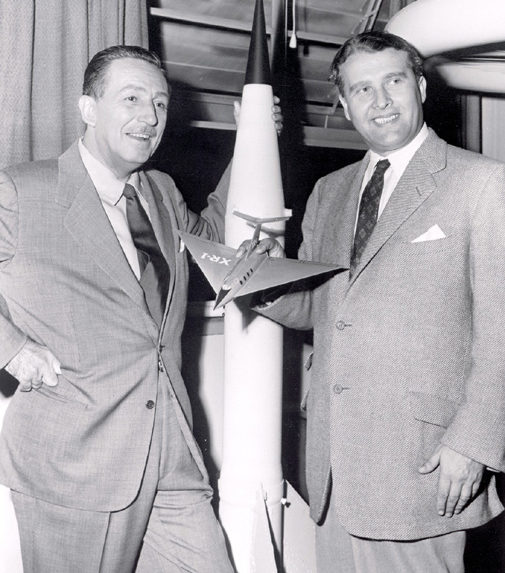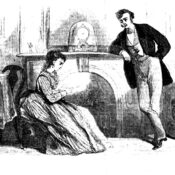In the 1920s and ’30s, Hollywood changed from a sleepy suburb of Los Angeles to a world power. And in those days, there were giants: studio executives who wielded immense power over every aspect of movie production. People like Sam Goldwyn, Louis B. Mayer, the Warner Brothers, and the team of Chaplin-Pickford-Fairbanks churned out hundreds of movies that shaped the tastes of movie-goers around the world. They also created powerful corporations that perpetuated their names long after their deaths.
We’ve come a long way from those days. The great studios are now capital investments traded between corporations — sold, repackaged, and sold again. One exception remains, though. It is the empire — or, rather, the Magic Kingdom — of Disney. Family members, particularly the son of Walt Disney’s partner and brother, Roy, still exert a strong influence over production and the Disney brand.
Walt’s birthday, December 5, prompted us to look back at the early Disney, long before Disneyland and Mickey Mouse, back the very humble beginnings of an American tycoon. Walt Disney began with little more than a public education, a few art courses in Chicago, and a year’s service as an ambulance driver in France. From this, and $500 of poker winnings he’d made overseas, he tried to become an animation studio in Kansas City.
His daughter, Diane Disney Miller, described “Dad’s” discouraging start in a Post biography:
“Sometimes he’d hear from his older brother, my Uncle Roy, who’d gone West to recuperate from the lingering effects of exposure endured in the Navy in World War I… If he hadn’t heard from Dad recently, he’d write, “Kid, I have a hunch you could use a little dough. So I’m enclosing a blank check. Fill it out for any amount you need up to thirty dollars.
“Dad always filled it out for thirty, and used the money to appease two Greeks, owner of a restaurant where he ate on the cuff…
“When Dad’s restaurant tab climbed past sixty dollars, one of the Greeks came up to see him. ‘Walter,’ he said, ‘believe me, I’d give you unlimited credit. But my partner says fun’s fun; we’ve got to cut you off.’
“‘All right, Jerry,’ Dad said. ‘I understand.’
“Two days later Jerry… saw Dad sitting on a box, eating cold beans from a can and dry bread. They were picnic leftovers, abandoned in a photographer’s studio next door. Dad had lived on beans and bread for two days.
“When Jerry came in and saw him munching that dismal meal, he melted. ‘Walt,’ he said, ‘I don’t care what Louis says. You come down to our place and get something to eat.’
“When Dad was telling me this story, I asked, ‘Wasn’t that about the low point of your life?’
“‘No,’ he said, ‘It wasn’t bad. I love beans.’
“When things seemed blackest, [a doctor] asked Dad to make an animated cartoon to teach children to take care of their teeth. Dad told him he could do the film for $500. One night the doctor called Dad to say, ‘I’ve got the money… Come over and let’s set this deal.’
“‘I can’t,’ Dad said.
“‘Why not?’
“‘I haven’t any shoes,’ Dad said. ‘They were falling apart and I left them at the shoemaker’s. He won’t let me have them until I can dig up a dollar and a half.’
In Kansas City, Walt landed a job in an advertising agency after showing cartoons he’d drawn while in France. He quickly learned his academic studies hadn’t prepared him for the commercial world.
“‘When you go to art school you work for perfection,’ he says now. ‘But in a commercial-art shop you cut things out, and paste things over, and scratch around with a razor blade. I’d never done any of those things in art school. Those are time-saving tricks. I learned them in six weeks.’”
“Dad began to work for the Gray Advertising Company in December, 1919. In November, when the pre-Christmas rush was over, he was laid off. He went to the Post Office and got a job carrying Christmastime mail. At night he worked in his bedroom, drawing samples, using tricks he’d learned at the art shop.
Walt began making cartoons, which he sold to a local theater owner.
“being so young, he made mistakes. He’d figured the cost of his raw film and its processing at thirty cents a foot. When Milton Field asked, ‘How much does this cost?’ Dad blurted out his basic cost price. He forgot to add a margin of profit. Field bought the cartoon and Dad was stuck with doing the job at cost. But he consoled himself; what he got would pay for more experimentation.”
The idea never caught on, and Walt quickly exhausted his savings. Abandoning cartoons, he set out for Hollywood in 1923, hoping to find work in the movies.
“When Dad stepped aboard the Santa Fe’s California Limited in Kansas City, bound for Hollywood, he wore a threadbare pair of pants and a checkered coat. He didn’t own a real suit of clothes. His imitation-leather suitcase contained one shirt, two pairs of underdrawers, two pairs of socks and some salvaged drawing material.”
He found, to his chagrin, that animators were thriving in Hollywood.
“Dad thought, ‘I should have hit the cartoon business six years ago. Now it’s too late.'”
The beginning of Walt’s success came with his “Alice in Cartoonland” series; a mixture of live action and animation, which he produced with his brother, Roy.
“Dad shot the little girl who played ‘Alice’ against a white backdrop. Then he drew the cartoons that went with her, and re-exposed the negative, frame by frame. He had trained his Uncle Robert’s police dog to take part in the proceedings, and organized a gang of neighborhood children to act as Alice’s pals. These kids were paid fifty cents each.”
Even with minimal costs, these productions soon exhausted their savings.
“When the young firm of Walt and Roy Disney got to the point where they had to borrow money or go under, Dad thought of Uncle Roy’s girl, back in Kansas City. Uncle Roy had been going with her for a long time before he’d headed west for hospitalization. ‘Why don’t you write to your girl Edna?’ Dad asked. ‘She’s got money.’ Uncle Roy wouldn’t hear of it. So Dad sent her a letter: ‘Don’t tell Roy I’ve written, but we need money. Can you lend us some, and if so, how much?’
“She had a job and she was living with her family, so she’d managed to save a little. Also, she was mighty fond of Uncle Roy. She sent dad a check; he can’t remember how much it was, but it came just in time.”
“Then dad told Uncle Roy what he’d done. ‘You’re going to be mad, but here’s her check. It’s money and we need it.’ Uncle Roy swallowed his pride.
“I’m sure that he has repaid his girl by this time, for later on he married her.”
Walt and Roy had secured a contract for 12 of their Alice cartoons, but the series hadn’t been very popular. After they released the sixth episode, the New York distributor tried to cancel the contract.
“He almost persuaded Dad and Uncle Roy to drop the whole thing, but a final conference stiffened their backbones. No cancellation, they said, because they’d already made Alice No. 7.
“When that one was delivered it was a smash hit.”
“I have asked Dad what the difference was between Alice No. 6 and Alice No. 7.”
“‘I honestly don’t know,’ he told me. ‘Maybe I was getting smarter at throwing gags to the audiences.’”
“Success changed everything. The distributor picked up his option for a second series of twelve films. Dad and Uncle Roy kept getting more money per reel each year, and the Alice in Cartoonland series lasted for three years. Dad can’t remember just how far the price went up, but he does know that five years later, when Mickey Mouse was born, his cartoons were bringing $2250 each.” (roughly $24,000 in 2009 dollars.)
The success continued throughout Walt’s life and far beyond. Today Disney Corp. is arguably the largest corporation in the entertainment industry. Its $60 Billion in assets include motion pictures studios, music studios, ABC television, ESPN, theme parks, and resorts in the U.S., Japan, and Europe. And just a few months ago, Disney acquired a new stable of animated heroes when it purchased Marvel Comics.
Today, the Disney family continues his legacy with senior Disney executive Roy Disney helping to maintain the dreams and principles of his uncle and his father.
When the Post recently asked Roy Disney about his thoughts on the company’s future, this is what he told us:
“I am an optimist by nature, but recognize that the Walt Disney Company of tomorrow will not be, and cannot be, the Walt Disney Company of yesterday.
“Enormous technological innovations across the media and entertainment landscape in the years ahead will probably result in a fresh, unique Disney. I am confident, however, that Disney’s unique values will remain in place no matter what the future brings.”
Become a Saturday Evening Post member and enjoy unlimited access. Subscribe now




Comments
Great article, Jeff. These are kind of stories I love. And at my age, I suppose that many of our mature readers love them, too. Keep up the good work.